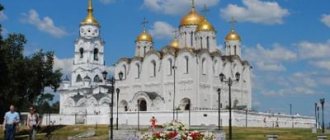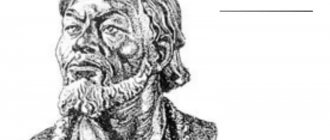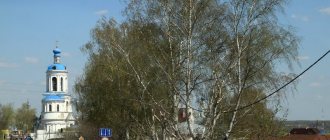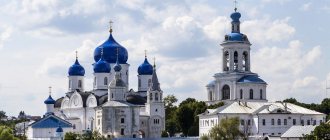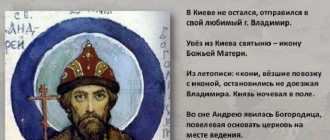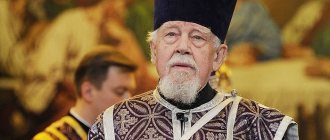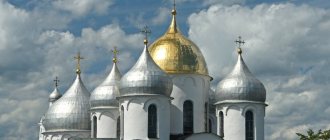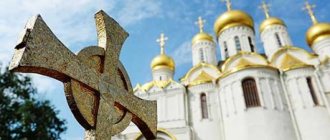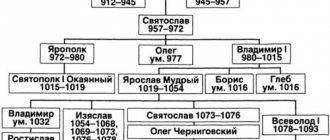1.Domestic policy
| Activities | results |
| 1.Strengthening princely power, the desire to be an autocratic ruler. | 1. He relied on the townspeople and the younger squad; the warriors ceased to be vassals of the prince, but became servants.2. persecuted and cruelly punished rebellious boyars 3. moved the capital to Vladimir-on-Klyazma, since there was no veche there. |
| 2. The desire to make Vladimir the spiritual center of Rus'. | An unsuccessful attempt, since the Patriarch of Constantinople did not agree to the creation of a patriarchate independent from Kyiv in Vladimir. He took the icon of the Vladimir Mother of God from Vyshgorod to Vladimir. He introduced new holidays: the Savior and the Intercession. |
| 3. The desire to extend power to all of Rus'. | 1. Temporarily subdued Novgorod2. He subjugated Kyiv, but did not want to rule from there; he put his Brother Gleb in charge. |
| 3. Further development of culture. | Active construction was underway. Under Bogolyubsky the following was built: - Church of the Intercession on the Nerl -Church of the Nativity of the Blessed Virgin Mary — Golden Gate in Vladimir - Assumption Cathedral in Vladimir He sought to free himself from the influence of Byzantium and invited Western European masters. The founder of Russian white stone architecture. |
| 4. Strengthening the economic power of the country. | Development of crafts and trade. Establishing new trade relations with countries, creating new trade river routes. |
Son of Dolgoruky
Andrey was the third son of Yuri Vladimirovich Dolgoruky. Historians consider the mid-1120s to be the approximate time of his birth. Presumably, in the early 1140s, Andrei Yuryevich married the daughter of the Moscow boyar Kuchka Ulita. It is not known for certain whether she was the only wife and mother of the prince’s four sons. His two older brothers - Rostislav and Ivan - died during the life of their famous father. Thus, by 1151 Andrei turned out to be the eldest of the heirs of Yuri Dolgoruky.
Young Andrei took part in civil strife together with his father, who fought for the Kiev table on the side of relatives from the Chernigov house of Rurikovich. In 1149, Yuri Dolgoruky expelled his Mstislavich nephews from Kyiv and became the Grand Duke. But the battle for the throne could not be over until other princes renounced their claims to the grand-ducal table or were destroyed. Kyiv passed either to Izyaslav Mstislavich, then back to Yuri Dolgoruky; the Chernigov and Ryazan princes constantly changed sides.
Finally, in 1155, Yuri Dolgoruky occupied the capital city of Rus' for the third and last time. In the same year, Andrei, imprisoned in Vyshgorod, against the will of his father, left for Vladimir, taking with him the future Russian shrine - the miraculous icon of the Mother of God. Andrei did not like the prospect of fighting for the prestigious Kiev throne, because holding the city required colossal forces and constant maneuvering between princely factions. He saw all this in the example of his father, who was allegedly poisoned by the Kyiv boyars in 1157 before another civil strife.
Installation of the icon of the Mother of God by Andrei Bogolyubsky in the Vladimir Bogorodtsky Church. (wikiwand.com)
Results of Andrei Bogolyubsky’s activities:
- The grand-ducal power, based on the nobility, was significantly strengthened, and the beginning of autocracy was laid.
- The influence of the Vladimir prince on Rus' expanded, and such important centers as Kyiv and Novgorod were subjugated. The Vladimir-Suzdal principality becomes the core of the future Russian state.
- There was further development of culture, its original features developed.
It was during his reign that masterpieces of world architecture were built.
- Significant strengthening of the country's economic power, establishment of new trade routes.
- Successful foreign policy.
Southern Troubles
Meanwhile, the restless Mstislav Izyaslavich managed to re-occupy Kyiv, abandoned by Gleb Yuryevich. However, after a month and a half, with the support of the Rostislavichs, the brother of Prince Bogolyubsky regained the Kiev table. The retreating Mstislav Izyaslavich unexpectedly fell ill and died in August 1170. Six months later, Gleb Yuryevich also died. Andrei Bogolyubsky believed that his brother was poisoned by the Kyiv boyars. Kyiv was occupied by Vladimir Mstislavich, but died three months later. The eldest of the Smolensk princes, Roman Rostislavich, became the new protégé on the Kiev throne. That time was the peak of Prince Bogolyubsky’s political career: the prince disposed of other people’s tables at his own discretion.
Former allies of the Rostislavichs turned into enemies after the change of princes in Novgorod. Moreover, Andrei Yuryevich demanded that those Kyiv nobles whom he suspected of killing his brother be handed over to him, but the Rostislavichs refused to do this. Then Prince Bogolyubsky ordered the brothers to leave the cities with which he had previously allocated them. The eldest, Roman Rostislavich, left the Kiev table and returned to Smolensk, but the three other brothers - Davyd, Rurik and Mstislav - decided to disobey. The prince planned to give the liberated Kyiv to his younger brother Mikhail, but he refused to accept the table, sending their youngest brother Vsevolod to the city in 1173. Davyd, Rurik and Mstislav captured Vsevolod, and at the same time the Kiev table, appointing Rurik Rostislavich prince. The Chernigov Olgovichi, led by Svyatoslav Vsevolodovich, took the side of the Vladimir prince, without forgetting, however, their main goal - the return of control over Southern Russia.
Almost the entire north of Rus' moved south, led by the still very young Novgorod prince Yuri Andreevich. The Vladimir-Suzdal residents were joined by the Ryazan, Murom, Rostov and Smolensk regiments. It was too heterogeneous an army, whose soldiers did not quite understand the purpose of their participation in the campaign against Kyiv, and were forced into the expedition, often without pursuing their own interests.
The people of Kiev opened the gates to the coalition army. The Rostislavichs fled to different cities: Rurik to Belgorod, Mstislav to Vyshgorod, and Davyd went for help to the Galician prince Yaroslav Osmomysl. The siege of Vyshgorod began and lasted nine weeks. In November 1173, the troops of Yaroslav Izyaslavich, the brother of the once Kyiv prince Mstislav Izyaslavich, approached Kiev. Previously, he agreed with Davyd Rostislavich to transfer Kyiv to him in exchange for helping his brothers in the war with the princely coalition. Having united with the forces of Rurik, Yaroslav Mstislavich moved towards the besieged Mstislav.
The news of the approach of a rumored strong army caused panic among the motley army, which began to retreat. Mstislav attacked them in the back, completing the rout. For the second time, the troops of Prince Bogolyubsky fled with significant numerical superiority.
What's next?
As is known from any short biography of Andrei Bogolyubsky, soon after the death of the prince, an active struggle began for everything that the great ruler had created. What seems surprising to many is the fact that the sons were not real contenders for reign - they completely agreed with the law of the ladder. In the Ipatiev Chronicle, recorded under the control of the Vladimir polychron of the fourteenth century, the murdered prince was first called great. In many ways, the title was explained precisely by the nuances of his death.
From Klyuchevsky’s conclusions it is known that Andrei can be described as a person who forgot himself in battle, wandered into the most dangerous places, and did not pay attention to the risks. Strife and danger were for him like water for fish - and this quality generally characterized many southern residents. Unlike his contemporaries, Andrei could not only be active in battle, but also quickly come to his senses, as soon as he had to think sensibly about something. The warlike intoxication, which just a minute ago made his eyes shine, passed almost instantly, and in the middle of the battle the prince could become cautious and reasonable, observant, careful - a real ruler in control of the situation.
It is noted that Andrei was prudent, he had everything ready at any moment for how events would unfold. This man was not taken by surprise by any circumstances, and no matter how great the chaos was around, Andrei maintained clarity of mind. He expected danger every minute, tried to put everything around him in order, and in many ways was similar to Vladimir Monomakh. Dared in battle, Andrei admitted that he did not like to fight. While the father was still alive, after each successful battle the son turned to him, asking for reconciliation with the vanquished.
Slavic colonization of Zalesye
Vasily Klyuchevsky wrote that during the time of Andrei Bogolyubsky, there was already a clear hostility between the inhabitants of South and North-Eastern Rus', which “initially had not a tribal or regional, but a social basis: it developed from the annoyance of South Russian townspeople and warriors at the smerds and slaves who escaped from their hands and went north; they paid, of course, with corresponding feelings.” Did the people of Kiev and Suzdal really hate each other so much already in the 12th century?
I respect Vasily Osipovich Klyuchevsky, but here he is not entirely right. The Slavic colonization of the territory of present-day Central Russia was carried out mainly by free people personally, and not by smerds and serfs. Moreover, this was a long process that began only in the 10th century, and in the 12th century, under Andrei Bogolyubsky, Slavic settlement in the Zalessk region (as the interfluve of the Volga and Oka was then called) was not yet completed.
While developing these territories, settlers from Southern Rus' gave local geographical objects names familiar to them from the Southern Russian lands. For example, the father of Andrei Bogolyubsky, Yuri Dolgoruky, founding a town on the shore of Lake Pleshcheevo in 1152, named it after the place where he was born - Pereyaslavl-Russky on the banks of the Dnieper south of Kiev (now Pereyaslav-Khmelnitsky in the Kyiv region of Ukraine).
Are you talking about Pereslavl-Zalessky, Yaroslavl region?
Yes, of course - that’s why he is Zalessky . The Trubezh River, at the confluence of which into Lake Pleshcheyevo stands Pereslavl-Zalessky, is named after the left tributary of the Dnieper Trubezh, where the current Ukrainian Pereyaslav-Khmelnitsky is located.
As for the supposed mutual hostility of the inhabitants of the Kyiv land towards the Suzdal residents, there is no need to exaggerate it. There were, of course, some contradictions between the populations of various Russian cities, but this was a normal phenomenon in the Middle Ages. It is impossible to talk about any special antagonism between Kiev and Suzdal.
We remember today
The bloody events of 1174 did not go unnoticed by history. The palace part where everything happened still stands to this day. In 1935, an anthropological study was carried out in Leningrad laboratories, which showed that the stories about the prince’s strength were completely true.
The man, who tirelessly fought against enemies from the outside, turned out to be unprepared for an internal attack, and his relatives and close associates were able to deal him a fatal blow. The resistance was desperate. If the prince had been able to survive that terrible night, death would certainly have awaited the conspirators - this was absolutely in the character of the ruler. The rebels themselves understood this, so they fought to the bitter end, no matter what the cost. What is curious is that, despite the looting of Kyiv’s holy places, the people revered Andrei as a bright prince and a worthy ruler.
How it all began
As far as is known from ancient history, Grand Duke Andrei Bogolyubsky was either the second or third child in the family. His father is the famous Yuri Dolgoruky, and his mother is the first wife of this famous ruler. The woman was the daughter of Khan Aepa. Born to Yuri Dolgoruky, Andrei Bogolyubsky, although he would become a famous ruler in the future, was not considered such at the time of his birth, and the child was not his father’s first. History has not conveyed to us the exact date of his birth. It is assumed that Yuri’s second child appeared in 1111. Information about the exact day when Andrei was born can be found in the “History” created by Tatishchev, but this book was written six centuries after the death of the Grand Duke, and an indication of the exact dates , given in it, raises doubts among many.
No information has been preserved to this day from reliable sources about how the childhood and youth of the person who would later occupy the position of Grand Duke passed. It is known that for his time this figure was one of the most important figures. His deeds told the world about this, and it was for them that he was remembered for many thousands of years.
Gradually but inevitably
A little earlier than the residents of Novgorod, the rule of Andrei Bogolyubsky was recognized by the Rostislavichs, and as a reward for this, Roman received the Kiev throne. The united lands of Suzdal and Vladimir under the reign of the great ruler received an increase. On the eastern side, the settlement of Gorodets-Radilov was founded, thanks to which Volga Bulgaria became subject, and on the northern side, the land was replenished with Zavolochye.
The policy of Andrei Bogolyubsky, whose center was military pressure, began to falter in the 70s. Mass campaigns, as practice has shown, do not show the desired result; there was a crisis. In 1172 they organized a battle with the Volga Bulgars, but noble people and allied principalities refused to support Andrei. Then the Rostislavichs rebelled. In 1174, punitive troops marched towards the Kyiv lands - numerous warriors from different lands united under the rule of Andrei. Despite the numerical superiority, the Grand Duke suffered an absolute defeat.
Modern historians suggest that a social crisis occurred during the reign of Andrei Bogolyubsky, and it is they who should explain his sudden failures during the 70s. The peremptory autocracy promoted by the prince was established by extreme military and fiscal measures, due to which the nobility became inflamed with discontent towards such a ruler. The conflict was both between the prince and the boyars of Suzdal and Rostov, and in the Vladimir lands. At one time, Andrei tried to form a layer of serving nobility loyal to him, which was supposed to become stronger than the clan boyars, but no success was achieved.
